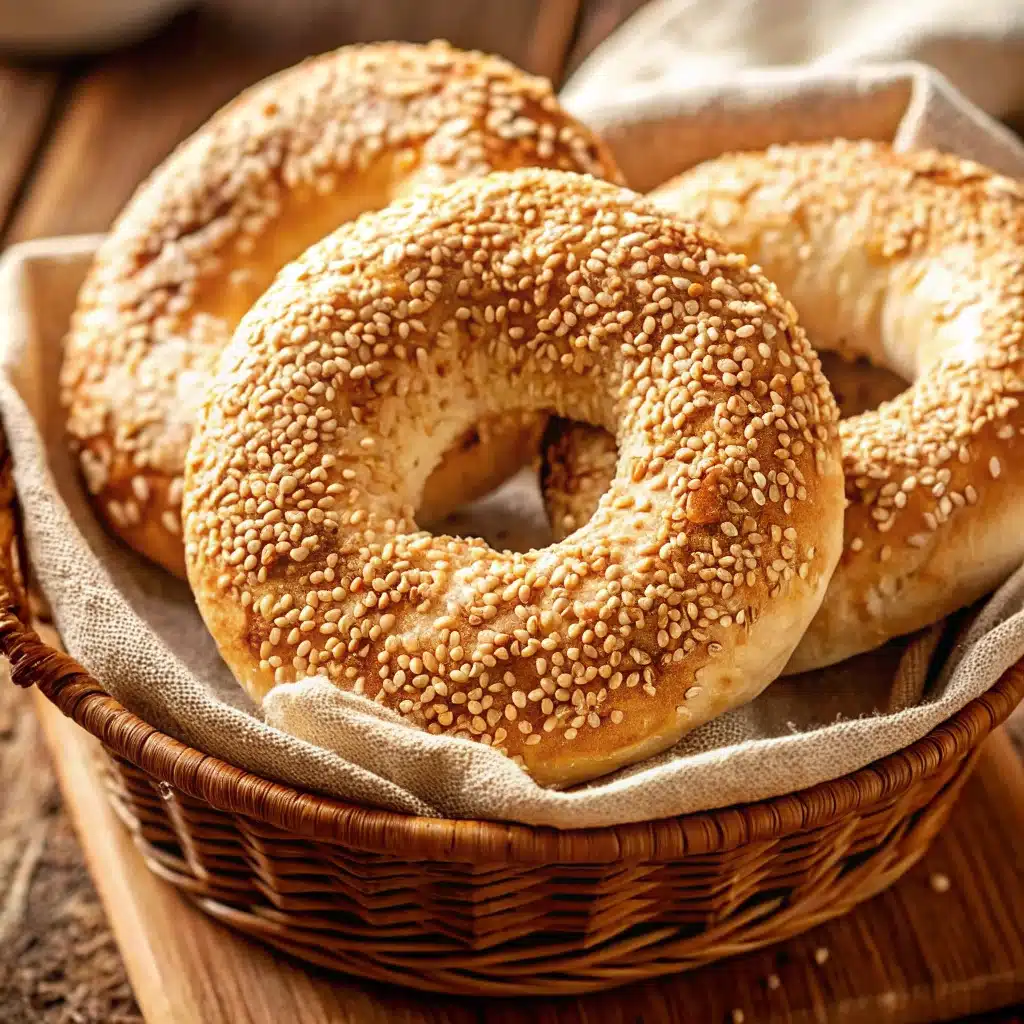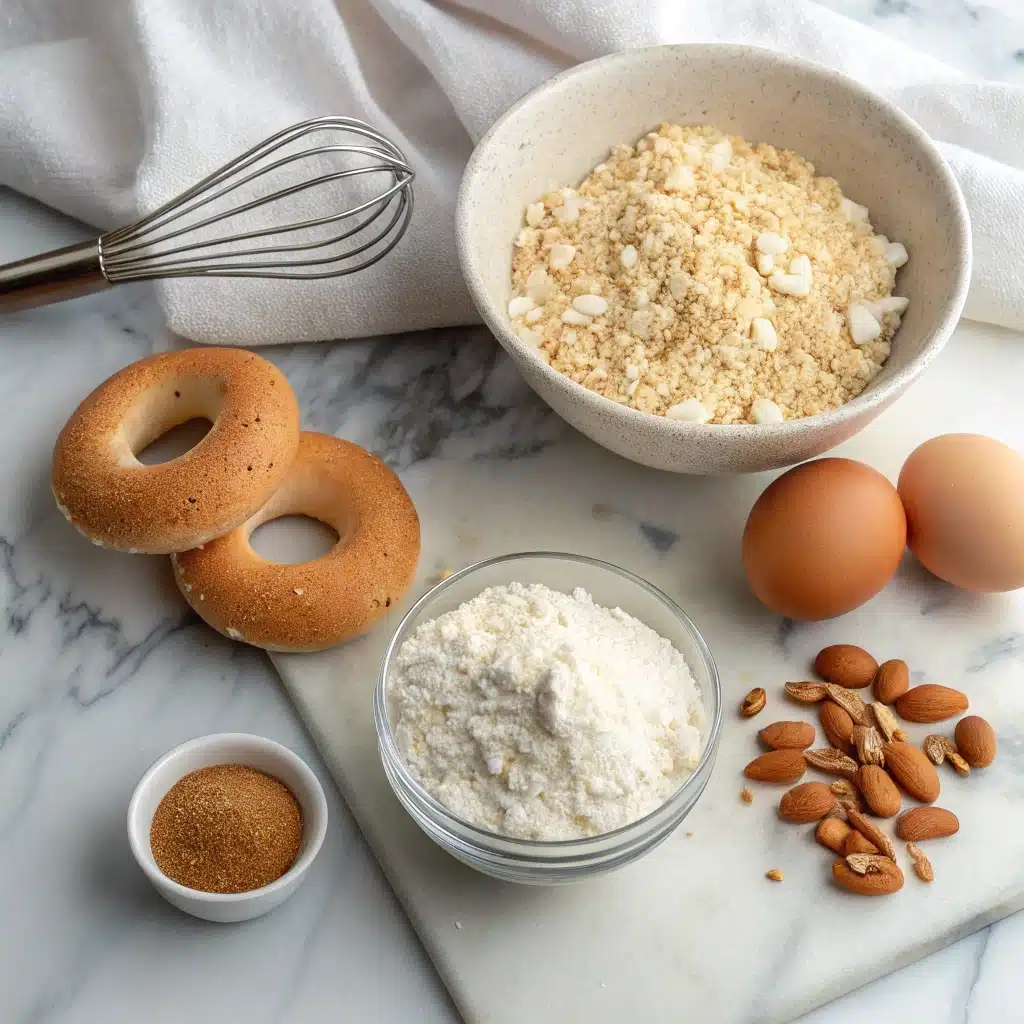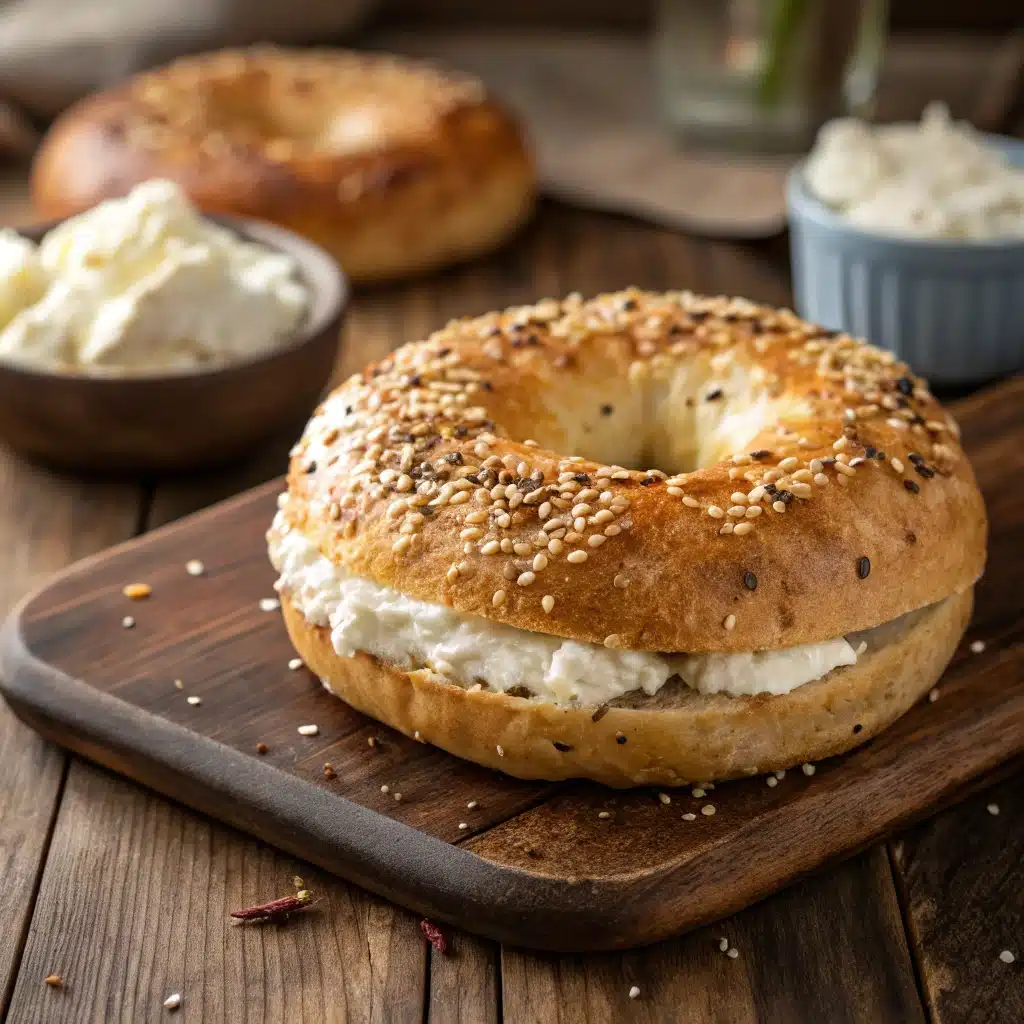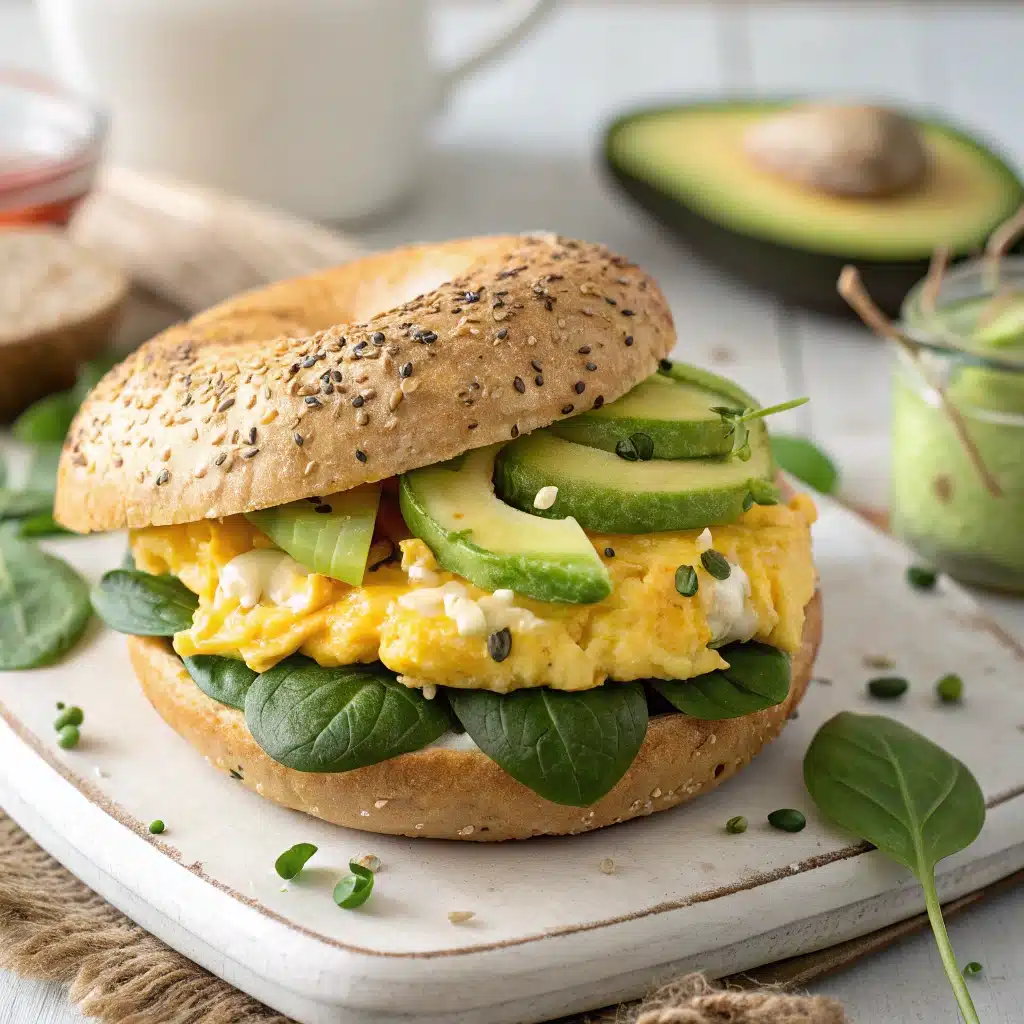Cottage cheese gluten free bagel is the perfect balance between indulgence and wellness. If you’re craving a chewy, satisfying bagel without the bloating effects of gluten, this is the ultimate solution. By combining gluten-free flours and the rich creaminess of cottage cheese, these bagels deliver high protein, low carbs, and full flavor in every bite.

What makes a cottage cheese gluten free bagel stand out isn’t just its nutritional profile—it’s the texture. Lightly crisp on the outside, moist and chewy inside, it rivals any bakery-style bagel while being gut-friendly and easy to digest. Whether you’re gluten-sensitive, following a low-carb lifestyle, or simply want to start your morning with more protein, this bagel fits the bill.
In this article, you’ll discover the full benefits of making your own cottage cheese gluten free bagels at home. We’ll walk you through their nutritional breakdown, key ingredients, baking method, storage tips, and even answer FAQs about how long they last or why yours might turn out dense.
Looking for inspiration? Try our High Protein Cottage Cheese Bagels Recipe to get started with a foolproof version.
Table of Contents
Understanding Cottage Cheese Gluten Free Bagels
What is a Cottage Cheese Gluten Free Bagel?
A cottage cheese gluten free bagel is a high-protein, gluten-free baked good made by replacing wheat flour with grain-free or gluten-free flours and incorporating protein-rich cottage cheese into the dough. These bagels are softer and denser than traditional ones and don’t require proofing or boiling.
Perfect for breakfast, snacks, or sandwiches, they’re easy to make at home and even easier to adapt to different diets—including low-carb, sugar-free, or lactose-free versions.
Why people love them:
- Naturally gluten-free and yeast-free options available
- High in protein and often low in carbs
- Moist, chewy texture from the cottage cheese
- Quick to prepare and bake at home

Cottage Cheese Gluten Free Bagel
- Total Time: 35 minutes
- Yield: 4 bagels 1x
Description
A high-protein, low-carb, and gluten-free bagel made with creamy cottage cheese and nutrient-dense flours—perfectly chewy, moist, and gut-friendly.
Ingredients
- 1 cup cottage cheese (full-fat or low-fat)
- 1 egg (plus 1 for egg wash)
- 1¼ cup almond flour
- ¼ cup tapioca flour
- 2 tbsp oat flour (optional)
- 1 tsp baking powder
- ½ tsp sea salt
- ½ tsp garlic powder (optional)
- Sesame seeds or everything bagel seasoning (for topping)
Instructions
- Preheat oven to 375°F (190°C) and line a baking tray with parchment paper.
- Blend cottage cheese and one egg in a blender until smooth.
- In a bowl, whisk almond flour, tapioca flour, oat flour, baking powder, salt, and garlic powder.
- Combine the blended mixture with dry ingredients to form a dough. Add 1–2 tbsp more oat flour if too sticky.
- Divide dough into 4 parts, roll each into a log, and shape into bagels.
- Brush with beaten egg and sprinkle toppings.
- Bake for 22–25 minutes until golden brown.
- Let cool on a rack for 10 minutes before serving.
Notes
Can be stored in fridge for 5–7 days or frozen for up to 3 months. For a crisp finish, toast before serving.
- Prep Time: 10 minutes
- Cook Time: 25 minutes
- Category: Breakfast
- Method: Baking
- Cuisine: Gluten-Free
Nutrition
- Serving Size: 1 bagel
- Calories: 200
- Sugar: 1g
- Sodium: 350mg
- Fat: 8g
- Saturated Fat: 2g
- Unsaturated Fat: 5g
- Trans Fat: 0g
- Carbohydrates: 22g
- Fiber: 3g
- Protein: 14g
- Cholesterol: 45mg
How is it Different from Regular or Traditional Bagels?
Unlike classic bagels that use wheat flour, yeast, and a boiling step before baking, cottage cheese gluten free bagels are simpler, cleaner, and more nutritious.
Here’s a detailed comparison:
| Feature | Traditional Bagel | Cottage Cheese Gluten-Free Bagel |
|---|---|---|
| Main Flour | Wheat | Almond, oat, or tapioca |
| Gluten-Free | No | Yes |
| Protein Source | Minimal | Cottage Cheese |
| Yeast Required | Yes | Optional or No |
| Texture | Chewy and elastic | Soft, moist, slightly dense |
| Preparation Time | Longer (includes proofing) | Shorter (no rise time needed) |
| Digestive Friendly | Often heavy | Light and easy to digest |
If you’re gluten-sensitive or looking to increase your protein intake without added sugars or flours, these bagels are your perfect match.
Check out our Cottage Cheese Bagels Recipe to make your first batch with ease.
Nutritional Value of Cottage Cheese Gluten Free Bagels
Protein Content and Muscle Support Benefits
One of the standout reasons people choose a cottage cheese gluten free bagel is its high protein content. Unlike traditional bagels that are mostly carbs with minimal protein, these bagels offer a balanced macronutrient profile. The inclusion of cottage cheese—rich in casein protein—helps support muscle repair and keeps you fuller longer.
For fitness enthusiasts and busy professionals alike, getting in protein early in the day is key. A single cottage cheese gluten free bagel can provide anywhere from 12 to 18 grams of protein, depending on the type of cottage cheese and flour used. That makes it an ideal post-workout meal or breakfast that won’t spike your blood sugar like refined carb bagels.
Here’s a comparison:
| Nutrient | Traditional Bagel (Plain) | Cottage Cheese Gluten Free Bagel |
|---|---|---|
| Calories | ~275 | ~180–220 |
| Carbohydrates | 55g | 18g–28g |
| Protein | 7g | 12g–18g |
| Fat | 1g | 5g–9g |
| Gluten Content | High | 0g (Gluten-Free) |
Including these bagels in your diet can help you hit daily protein targets without loading up on empty carbs. Plus, they’re naturally lower in sugar.
Looking for inspiration? Try our Vegan and Gluten-Free Cupcakes if you’re exploring more high-protein, gluten-free options.
Calorie, Carb, and Fat Comparison with Regular Bagels
Another major benefit of a cottage cheese gluten free bagel is the reduction in refined carbohydrates. Regular bagels are typically made from white or enriched wheat flour, which can spike insulin levels and contribute to energy crashes. But when you use almond flour, oat flour, or coconut flour as a gluten-free base, you significantly reduce carb count while boosting fiber.
Most homemade versions of these bagels also contain healthy fats—especially if you use almond flour or add flaxseeds. These fats support heart health and keep you satiated longer than simple sugars or starches.
If you’re counting macros or following a ketogenic or paleo lifestyle, this bagel fits right in. It’s naturally:
- Low-glycemic
- High in protein
- Moderate in healthy fats
- Free of refined sugars
So not only does a cottage cheese gluten free bagel taste great, but it also aligns with smart eating goals like weight loss, muscle maintenance, and blood sugar control.
Discover great ideas like our Blueberry Crumble Gluten Free for another guilt-free treat that’s low in carbs and big on taste.
Main Ingredients and Their Benefits

Why Cottage Cheese is a Smart Baking Ingredient
The creamy, tangy magic of cottage cheese is the heart of every good cottage cheese gluten free bagel. But why does it work so well in baking?
Cottage cheese is not just a source of protein—it also provides moisture, richness, and structure to baked goods. Its curds melt slightly during baking, creating pockets of softness without needing added oils or butter. And because it’s naturally lower in fat and carbs compared to other dairy products, it supports a leaner bagel that still feels indulgent.
Here’s what makes cottage cheese an ideal ingredient for gluten-free baking:
- High Protein: Essential for structure and satiety
- Moisture Retention: Keeps bagels soft without gluten
- Low Fat Options Available: Great for calorie control
- Mild Flavor: Pairs with sweet or savory toppings easily
In a gluten-free recipe, where texture can be tricky, cottage cheese acts like a binding and softening agent. You’ll often find it in protein pancakes, low-carb breads, and muffins for the same reason.
Don’t miss our Mini Blueberry Bundt Cakes for another moist, cottage cheese-inspired recipe.
Which Flours are Used for Gluten-Free Bagels and Why
Since a cottage cheese gluten free bagel doesn’t rely on wheat, choosing the right flour is key to achieving a chewy-yet-soft texture. Different gluten-free flours bring different qualities to the dough. Let’s break down the most common types:
| Gluten-Free Flour | Benefits | Best For Texture? |
|---|---|---|
| Almond Flour | High in protein, low carb, nutty taste | Yes |
| Oat Flour | Mild, hearty, and rich in fiber | Yes |
| Tapioca Flour | Adds chewiness and elasticity | Yes |
| Coconut Flour | Low carb, absorbs moisture fast | Use sparingly |
| Brown Rice Flour | Subtle taste, balances texture | Optional |
| Psyllium Husk Powder | Boosts fiber and structure | Great addition |
When used together, these flours create a well-balanced dough. For example, almond flour provides moisture and protein, while tapioca flour contributes to the bagel’s signature chew.
Many homemade recipes also include baking powder or soda to help the dough rise without yeast, making the recipe faster and simpler.
Looking for more creative ideas with gluten-free ingredients? Check out our Peach Muffins—a fruity, gluten-free bake that complements any healthy diet.
Step-by-Step Recipe for Cottage Cheese Gluten Free Bagels

Simple Homemade Recipe with Basic Pantry Ingredients
Making your own cottage cheese gluten free bagel at home is easier than you think—and you don’t need fancy equipment or rare ingredients. This recipe is quick, requires no yeast, and comes together in just about 30 minutes.
Ingredients (Makes 4 medium bagels):
- 1 cup cottage cheese (full-fat or low-fat)
- 1 egg (plus 1 for egg wash)
- 1¼ cup almond flour
- ¼ cup tapioca flour (for stretch and chew)
- 2 tbsp oat flour (optional, for texture)
- 1 tsp baking powder
- ½ tsp sea salt
- ½ tsp garlic powder (optional, for savory flavor)
- Sesame seeds or everything bagel seasoning (for topping)
Instructions:
- Preheat Oven: Set your oven to 375°F (190°C). Line a baking tray with parchment paper.
- Blend Cottage Cheese: Add the cottage cheese and one egg into a blender or food processor. Blend until smooth and creamy.
- Mix Dry Ingredients: In a large bowl, whisk almond flour, tapioca flour, baking powder, salt, and garlic powder.
- Combine: Pour the blended cottage cheese mixture into the bowl with the dry ingredients. Mix with a spatula until it forms a dough. If it’s too sticky, add 1–2 tbsp more oat flour.
- Shape the Bagels: Lightly flour your hands with oat or almond flour. Divide the dough into 4 equal parts. Roll each into a log and connect the ends to form a bagel shape.
- Egg Wash & Toppings: Beat one egg and brush it on top of the bagels. Sprinkle with sesame seeds or seasoning.
- Bake: Place on the prepared tray and bake for 22–25 minutes, or until golden brown and firm on top.
- Cool: Let them cool on a rack for 10 minutes. Slice and enjoy warm or toasted!
These bagels can be frozen for up to 3 months or stored in the fridge for a week. They’re perfect plain, or with avocado, eggs, or nut butter.
Looking for more quick bakes? Don’t miss our Blueberry Crumble Gluten Free for another healthy, satisfying option.
Tips for Mixing, Shaping, and Baking to Perfection
To make your cottage cheese gluten free bagel turn out bakery-worthy, here are a few expert tips:
- Use smooth cottage cheese or blend curd-style cottage cheese for a better dough texture.
- Chill the dough for 10–15 minutes if it’s too sticky to handle.
- Don’t overbake—the bagels will continue cooking while cooling and can dry out easily.
- For extra crispness, toast them after baking or broil for 2 minutes before serving.
- Want more chew? Add 1 tsp psyllium husk or xanthan gum.
Bagels too soft? Add a tablespoon of oat flour. Too dry? Mix in a teaspoon of olive oil or an extra spoon of cottage cheese.
Check out our Cottage Cheese Bagels Recipe for another version with optional toppings and flour swaps.
Texture, Taste, and Customization Options
What Makes These Bagels Moist, Soft, and Chewy
One of the best features of a cottage cheese gluten free bagel is its signature texture. Unlike many gluten-free baked goods that turn out dry or crumbly, these bagels stay moist inside while developing a light golden crust outside. The secret? It’s the combination of cottage cheese and high-moisture gluten-free flours like almond or oat.
Here’s why they work:
- Cottage cheese adds creaminess and replaces traditional oil or butter
- Tapioca flour enhances chewiness and mimics the elasticity of gluten
- Eggs bind the ingredients and create a more unified dough structure
While traditional bagels rely on gluten for their stretch and chew, this recipe recreates that texture using a smart blend of protein, moisture, and starches.
Pro tip: Letting the bagels rest for 10 minutes after baking improves texture and makes slicing easier. Also, toasting them the next day revives the crust and adds a hint of crisp.
Want to try other moist bakes? Don’t miss our Peach Muffins—another soft, gluten-free treat perfect for breakfast.
Flavor Variations: Savory, Sweet, and Everything In-Between
One of the best parts about baking your own cottage cheese gluten free bagel is customizing it to your taste. The base recipe is mild and creamy, making it a perfect canvas for both sweet and savory variations.
Here are some popular options:
Savory Add-ins:
- Chopped chives, onion flakes, or rosemary
- Grated parmesan or cheddar cheese
- Sundried tomatoes and olives
- Cracked black pepper and garlic powder
Sweet Versions:
- Mix in cinnamon and a touch of maple syrup or honey
- Add raisins, dried cranberries, or mini chocolate chips
- Use vanilla extract and top with sliced almonds
Toppings to Try:
- Everything bagel seasoning
- Sesame, chia, or poppy seeds
- Crushed walnuts or cinnamon sugar (for sweet bagels)
Flavor Match Table:
| Variation Style | Add-In Example | Suggested Topping |
|---|---|---|
| Savory | Chopped herbs, cheese | Everything seasoning, sesame |
| Sweet | Cinnamon, vanilla, raisins | Almond slivers, coconut sugar |
| Spicy | Jalapeños, red pepper flakes | Crushed chili, sea salt |
| Gourmet | Caramelized onions, feta | Nigella seeds, thyme |
Looking for dessert-style variety? Try our Vegan and Gluten-Free Cupcakes for more inspiration on flavor-forward gluten-free baking.
Storage, Freezing, and Reheating Tips for cottage cheese gluten free bagel
How Long Do Protein Bagels Last in the Fridge or Freezer?
Proper storage is key to getting the most out of your homemade cottage cheese gluten free bagel. Because these bagels are made with dairy and no preservatives, their shelf life is shorter than standard store-bought versions—but with the right methods, you can enjoy them for days or even weeks.
Here’s how long they last:
| Storage Method | Duration | Tips |
|---|---|---|
| Room Temperature | 1–2 days (max) | Store in airtight container in a cool area |
| Refrigerator | 5–7 days | Use a zip bag or sealed container |
| Freezer | Up to 3 months | Freeze individually wrapped bagels |
Always let bagels cool completely before storing. Warm bagels can create condensation in containers, leading to sogginess or mold. For freezer storage, wrap each bagel in parchment paper and store in a freezer-safe bag to prevent freezer burn.
Don’t miss our Blueberry Crumble Gluten Free for another freezable treat that retains its flavor and texture.
Best Ways to Store Gluten-Free Bagels for Freshness
To preserve the soft, chewy texture of a cottage cheese gluten free bagel, moisture management is critical. Unlike wheat-based bagels that hold up longer at room temp, gluten-free varieties dry out faster if not sealed properly.
Here are quick do’s and don’ts for maintaining freshness:
Do:
- Store in airtight bags or silicone containers
- Freeze bagels on baking day if not eaten within 48 hours
- Slice before freezing for easy toasting
Don’t:
- Leave bagels exposed to air
- Refrigerate in loosely covered bags
- Defrost on the counter uncovered (use a towel or microwave)
Reheating Tips:
- Toaster or toaster oven: Best for restoring crisp edges
- Microwave: Wrap in a damp paper towel and heat for 20–30 seconds
- Oven: Bake at 300°F for 8–10 minutes from frozen for a fresh-baked taste
This makes cottage cheese gluten free bagels ideal for batch prep—bake once, eat all week.
Looking for more make-ahead options? Check out our Mini Blueberry Bundt Cakes—perfect for freezing and reheating on busy mornings.
Troubleshooting Common Problems
Why Are My Gluten-Free Bagels Too Dense or Gummy?
One of the most frequent complaints with any gluten-free baking—especially when cottage cheese is involved—is ending up with dense, heavy, or even gummy bagels. If your dough isn’t turning out like the light, chewy version you’re aiming for, you’re not alone.
Here’s what might be causing the problem:
| Problem | Likely Cause | Solution |
|---|---|---|
| Too Dense or Heavy | Overmixing or too much almond flour | Mix until just combined. Use a flour blend. |
| Gummy Texture | Underbaking or too much moisture | Bake longer and let cool before slicing. |
| Cracked or Dry Exterior | Oven too hot or not enough moisture in dough | Add a touch of olive oil or reduce temp slightly |
| Flat Bagels | Batter too loose or no structure agents (egg/xanthan) | Add an extra egg or 1 tsp psyllium husk |
Tip: Gluten-free dough behaves differently than wheat dough. If you treat it like bread dough and overwork it, you’ll often end up with compact results.
Also, don’t skip the resting step after baking—cooling allows the structure to set and moisture to distribute evenly. Bagels that are sliced too early can feel mushy or underdone, even if fully baked.
How to Fix Texture and Dough Issues Easily
If your cottage cheese-based dough feels too wet or sticky to shape, don’t panic. This is common, especially if you’re using full-fat dairy or high-moisture flours like coconut or oat.
Fixes for Sticky Dough:
- Add 1–2 tablespoons more almond or oat flour
- Let dough rest in the fridge for 10–15 minutes
- Use lightly oiled hands when shaping
To Improve Texture and Rise:
- Add a small amount of baking powder (½ tsp extra)
- Use a combination of flours (almond + tapioca = great structure)
- Include an egg yolk for richness if the dough feels flat
Finally, don’t forget: gluten-free dough doesn’t stretch—it shapes with compression. Use your fingers to gently mold your bagel rings instead of trying to roll and twist like traditional bagels.
For more moisture-rich inspiration, explore our Peach Muffins—they also rely on balanced ratios of dairy and flour.
Healthy Meal Ideas Using Cottage Cheese Bagels

High-Protein Breakfast Sandwich Combinations
Start your morning strong with a protein-packed sandwich using a cottage cheese gluten free bagel as the base. Thanks to its creamy texture and subtle flavor, this bagel pairs perfectly with both savory and fresh toppings. Whether you’re fueling up post-workout or prepping a make-ahead breakfast, these combos deliver serious nutrients without the gluten.
Here are a few go-to combinations:
| Combo Name | Ingredients | Why It Works |
|---|---|---|
| Power Morning | Scrambled egg whites, avocado, arugula, hot sauce | High in protein and healthy fats |
| Classic Protein Boost | Turkey bacon, tomato, spinach, low-fat cheddar | Balanced macros and flavor |
| Veggie Delight | Grilled zucchini, red bell pepper, hummus | Vegan-friendly and full of fiber |
| Sweet & Protein-Rich | Peanut butter, banana slices, chia seeds | A great option for post-workout refuel |
| Smoked Salmon Deluxe | Smoked salmon, cucumber, dill, dairy-free cream cheese | Omega-3s and refreshing crunch |
Each of these can be prepped the night before and stored in the fridge—just toast the bagel in the morning and assemble!
Looking for inspiration for your breakfast routine? Try our High Protein Cottage Cheese Bagels Recipe and transform it into any of the ideas above.
Kid-Friendly Snacks and Low-Carb Lunch Box Options
These gluten-free bagels aren’t just for adults. Because they’re soft and customizable, they work great in school lunches or as a healthy snack for kids. And since they’re lower in carbs, they make an ideal base for keto-friendly or diabetic-conscious meals, too.
Kid-Friendly Snack Ideas:
- Mini bagel pizzas (with tomato sauce and mozzarella)
- PB&J on toasted bagel halves
- Cream cheese with apple slices and cinnamon drizzle
- Cheese and turkey roll-ups inside halved bagels
Low-Carb Lunch Box Fillers:
- Half bagel with tuna salad and sliced cucumber
- Greek yogurt and a toasted bagel half with almond butter
- Bagel wedges with guacamole and cherry tomatoes
- Hard-boiled egg and mini bagel with pesto spread
Tip: Bake smaller bagels (or shape into bites) for portion-controlled snacks that fit perfectly in bento boxes.
Don’t miss our Vegan and Gluten-Free Cupcakes for dessert pairings that stay within gluten-free guidelines.
Buying vs. Baking – Which One Is Better?
Best Store-Bought Gluten-Free Cottage Cheese Bagels
Not everyone has the time to bake from scratch. If you’re looking for convenience, several brands now offer high-protein, gluten-free bagels—some even include cottage cheese or similar dairy-based ingredients for added softness and flavor.
Here’s a comparison of popular brands that offer clean-label options:
| Brand Name | Key Features | Where to Buy |
|---|---|---|
| Carbonaut | Gluten-free, low carb, high fiber | Whole Foods, Amazon |
| O’Doughs | Dairy-free, soft texture, slightly sweet | Sprouts, Fresh Market |
| Outer Aisle | Cauliflower + cheese base, grain-free | Costco, Online Retailers |
| Udi’s Gluten-Free | Traditional texture, decent protein content | Walmart, Target |
While none of these replicate the exact flavor of a homemade cottage cheese gluten free bagel, they’re great options if you need something quick, portable, and allergen-friendly.
That said, you’ll rarely find versions that use fresh, whole ingredients like homemade recipes do.
When It Makes Sense to Bake Your Own from Scratch
If you want more control over ingredients, flavor, and nutrition, making your own bagels is the better choice. It lets you:
- Use clean ingredients like real cottage cheese, organic eggs, and almond flour
- Avoid preservatives, fillers, or gums
- Customize the taste, size, and texture
- Adjust for allergies or specific dietary needs (keto, paleo, etc.)
And let’s not forget cost-effectiveness. A single store-bought gluten-free bagel can cost $1.50–$3.00. Homemade versions come in much cheaper per serving and can be made in batches.
Here’s a quick side-by-side:
| Feature | Store-Bought Bagels | Homemade Option |
|---|---|---|
| Cost per Serving | $2.00–$3.00 | ~$0.80–$1.20 |
| Ingredient Control | Limited | Full control |
| Freshness | Varies | Fresh every time |
| Texture Flexibility | Fixed | Customize as you like |
| Nutritional Customization | Minimal | Fully adjustable (carbs, protein, etc.) |
So, if time allows, making your own high-protein bagels at home wins for both flavor and health.
Looking for the perfect recipe to try? Don’t miss our Cottage Cheese Bagels Recipe to get started the easy way.
FAQs
How long do protein bagels last?
Protein-based bagels typically last up to 5 days in the refrigerator when stored in an airtight container. If frozen, they can stay fresh for 2 to 3 months. Just make sure to cool them completely before sealing.
How long are gluten-free bagels good for?
Gluten-free bagels, especially homemade ones, are best eaten within 2–3 days at room temperature. To extend freshness, refrigerate for up to a week or freeze for longer-term storage.
Do cottage cheese bagels need to be refrigerated?
Yes. Because they include a dairy-based ingredient, it’s best to refrigerate them after cooling. This preserves texture and helps prevent spoilage.
Why are my gluten-free bagels so dense?
Dense or gummy texture usually comes from overmixing, not enough rising agents, or using only one type of gluten-free flour. Blend light flours (like tapioca or oat) with almond flour, and avoid overhandling the dough.
Conclusion: Why the Cottage Cheese Gluten Free Bagel Deserves a Spot in Your Kitchen
Whether you’re gluten-intolerant, aiming for a higher protein breakfast, or simply trying to make better food choices, the cottage cheese gluten free bagel is a standout solution. It’s soft, satisfying, and customizable for every lifestyle—from keto to kid-friendly.
When made at home, it gives you full control over what goes into your food. And when stored properly, these bagels hold up beautifully for meal prepping, breakfast sandwiches, or grab-and-go snacks.
Looking for more wholesome, gluten-free inspiration? Discover great ideas like our Vegan and Gluten-Free Cupcakes and Mini Blueberry Bundt Cakes for sweet, nutritious bakes that complement your wellness goals.
Fore more recipes follow me in Facebook, medium and Pinterest




